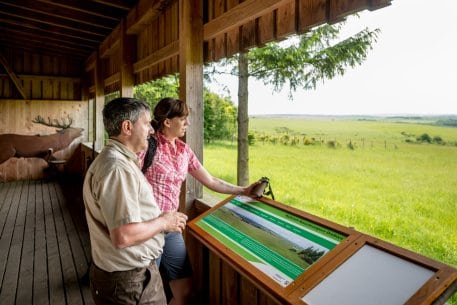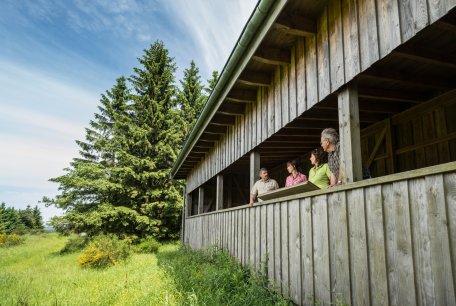Experience an unforgettable nature spectacle
The red deer observation gallery is not far from Dreiborn. This special observation point promises an unforgettable natural spectacle for both young and old. The autumn months - September and October in particular – ring in the rutting season, and red deer’s efforts concentrate on finding a mate: the male’s impressive self-promotion (also referred to as belling) echoes out across meadows, valleys and forests, and the belling sounds are audible miles away. You’ll have a good chance of discovering the magnificent deer there.
Life-sized, tactile models give visitors an impression of these four-legged animals’ impressive size, which are the largest free-living wild animals in Central Europe.
- During the entire rutting season, our expert rangers at the gallery are happy to provide answers to your questions. Equipped with binoculars, seat cushions and warm clothing, you’ll find everything you need!
- The observation gallery is not only worth visiting during the rutting season: with a little bit of luck, you can observe red deer all year round on Dreiborn plateau.
Special rules apply at the observation gallery. They are necessary to ensure that the animals won’t be disturbed and scared away. When following these rules, you and other visitors will be able to enjoy a truly special natural spectacle!
Rules of conduct for the observation gallery:
- Please be quiet on the way to the gallery and at the gallery
- Wear muted and low-noise clothing
- No dogs are allowed into the gallery (exceptions apply to guide dogs for the blind)
- Avoid sudden gestures on the benches
- Do not lean into the viewing window and do not enter the surface in front of the gallery.
- Do not use artificial light sources
- Shade your face with headgear, where possible
- Do not eat or drink in the gallery
- Remain quiet when you leave the observation platform
Thank you very much!
Information on accessibility
The red deer observation gallery is barrier-free, making it suited for wheelchair users. However, due to the steep access area, we recommend an accompanying person for wheelchair users.
During the rutting season, information is provided in Braille and tactile objects are available for blind visitors. Here, please contact the local rangers. To gain an impression of red deer, roe deer and wild boar, animal silhouettes can be touched in the left area of the gallery.
Information on how to reach us:
When arriving by bus, please use the "Dreiborn Kirche, Schleiden" bus stop.
When arriving by car, please use the "Rothirsch-Empore" car park, situated directly in front of the gallery, which is already signposted in Dreiborn. Alternatively, use the "Burg Dreiborn" car park, at the east entrance, or the "Dreiborner Hochfläche" car park, in the southwest. It is about 1.2 kilometres from the observation gallery.
Bird-Watching Station at Lake Urftsee
A bird-watching station between Gemünd-Malsbenden and Urft invites you to come and enjoy the expansive view across the dam with a telescope and explore its birdlife more closely. With a little bit of luck, you will find not only grey herons, Great Crested Grebe and ducks, but you can also observe cormorants.
The cormorant was hunted down for centuries, and finally became extinct in the West German interior following the Second World War. However, thanks to national and international protection regulations, its population levels have recovered well in Germany and Central Europe.
- Two high-quality telescopes with 15x magnification are permanently installed at different heights at the bird watching station. This makes this nature experience accessible to wheelchair users, too.
- A roll-under information board provides interesting facts on the landscape and draws attention to special aspects of the local birdlife.
- The path leading from Gemünd to the station is flat and paved.
The varied Eifel National Park landscape makes it home to a large variety of animal species. A number of woodpecker species feel right at home in the protected forest areas, and it’s not uncommon, for example, to observe red and black kites, as well as black stork at Urft dam. Grey herons, cormorants and other birds have their habitats in the surrounding lakes, rivers and streams.







